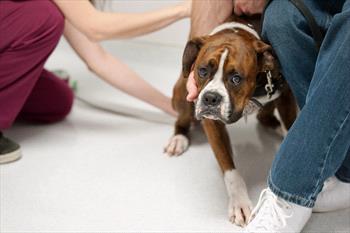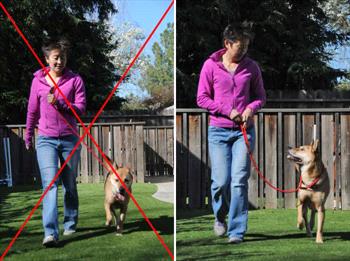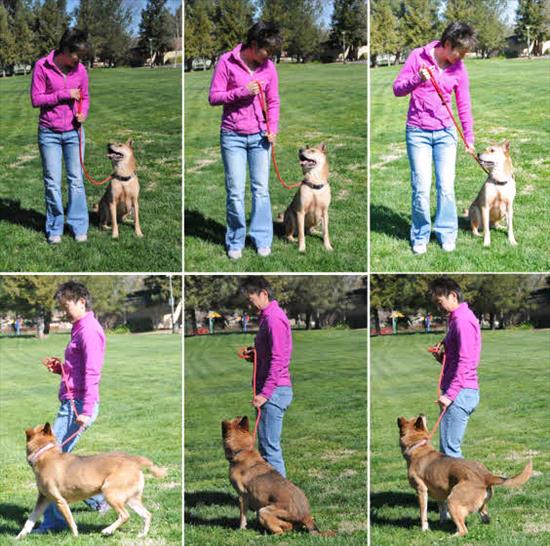
Veterinarians, shelter workers, and other professionals who work with dogs on a daily basis are always asking me, “If I’m dealing with a dog who can’t have treats because he’s having a procedure later in the day or because he’s not hungry, what can I do to get him to be more cooperative or to behave better?”
Creating a Relaxing Environment
Well, because the main reason dogs are anxious and uncooperative in the veterinary hospital and shelter situation is fear, my answer is, “It really would be helpful if you avoid scaring the poop out of the dog first.” By that, I mean, set up your waiting room, kennels, and holding areas so that they create a comfortable, relaxing environment for dogs instead of designing these areas to look like the casting call for “Revenge of the Ax Murderer’s and Zombies.” No, I’m not making a mean comment about the appearance of your staff. The point I’m making is that it doesn’t matter if you think you and your staff look cute and friendly or that you think it’s ok for howling, hyper dogs already present to heckle the new arrivals like inmates welcoming new prisoners to San Quentin. Many dogs find this loud, busy set-up to be scary and that’s the real issue.
Approaching a Fearful Dog
Now, say, you’ve managed to make your hospital, hound lounge, or humane society more inviting. The next golden rule is to stop greeting and approaching dogs in ways that freak them out. The number one way to freak a dog out is to approach him head on—and stick your ugly, warty hand out for him to sniff or to stick your big face right into his to give him a “friendly” kiss. Remember, even if you think you’re God’s gift to wayward pooches, to the pet who doesn’t know you well, your face or hand in his face is as welcome to him as the hug from a troll would be to you. So, instead of breaching the dog’s personal space or approaching in an impolite, threatening way, approach with your side or even back towards him and let him come to you if he wants to greet. In fact, with the very fearful dog, approach sideways or even backwards with every greeting and interaction of the very fearful dog until the dog’s completely comfortable with you at all times. Oh yes, here’s a helpful hint: when you walk away from the scared dog keep your eyes on him (face sideways as you leave). Scared dogs tend to bite people in the butt.
Guiding Fido in a Way He Understands
Ok, so say you’ve already got these two points down because you already knew these super-simple rules. What’s the next step you can take to help dogs look to you for guidance and direction instead of seeing you as the enemy or as someone as unsure of himself as him? A third method that also does not require food? Believe it or not, learning how to walk Fido from one place to the next in a way that makes it clear you’re know where you’re going is a huge. Why would this be? Well, imagine you’re blind and you’re relying on someone to lead you, but that person walks you into a table or you can’t tell where that person is trying to go. You probably wouldn’t trust that person to lead you for long, let alone help you through a medical procedure.
Most dogs aren’t blind, but they don’t understand when you say things like, “We are heading to kennel room A or kennel number 403.” They have to rely on your walking in a way that makes it clear where you intend to go. So what way is that? Here are several tips on moving and walking in ways that provide clear direction to dogs that you are trying to lead:
Tip 1: Walk fast enough so the dog knows you’re trying to lead him somewhere. If you walk slowly like you’re strolling the dog may wander aimlessly or sprint towards something more interesting.
Tip 2 (see video): Use your body movement and momentum to let the dog know where you’re going instead of just guiding him around with your arms. For instance, if you want your dog to follow you when you do an about-turn, keep moving your feet so that you keep turning. If you stand stationary and try to pull him around you into position, you’ll confuse the dog, which will be frustrating and even scary for him.
Tip 3: Make sure the dog is on a loose leash, with the leash hanging in a U, once you have him moving in the direction you want. Tighten the leash only if you change directions and he doesn’t follow, if you start moving or speed up and he doesn’t immediately move with you, or if you slow down or stop and he’s about to walk past you.
If the dog stops or veers off path or otherwise heads in the wrong direction, you’ll need to speed up a little in the direction you meant for him to go in order to make it clear.
Note: When the dog stops to sniff or pull in a different direction, I actually keep moving (even a little faster to build some momentum) in the direction I want with enough speed so that he knows I want him to follow. As soon as he’s heading in my direction, I loosen the leash. Because my movement makes the cues clear, the dog gets the message and catches up and happily looks at me. Since, in this particular scenario, the dog is not allowed to have a food reward (hospital situation or dog is not motivated for food at the moment), I’ll reward with praise or petting if the dog likes these things. Otherwise, the reward will have to be that I have communicated my message clearly to the dog and I’m walking at a pace that’s more comfortable/fun for him and provides good direction. Be careful that you don’t yank the dog, but rather you guide him in the same way someone would guide you by the arm when they are trying to guide you away from suddenly stepping in a hole. It’s best if the dog’s wearing a collar that does not tighten around his neck, although use whatever your facility or workplace requires. If you’re worried about pressure on the neck when you provide direction to the dog, then you’ll need to institute a rule that all dogs in your hospital, shelter or other professional situation come in on front-attaching harnesses. If you don’t give these dogs guidance, they will probably end up having more pressure on their neck as they dart off in random directions or as you unconsciously hold then on a tight leash. On the other hand, by providing direction to them in a clear manner, the dog will quickly learn that walking with you is fun and it’s how he gets to be on a loose leash.
Tip 4: People tend to accidentally hold the leash tight all the time when they are walking dogs, especially when the dog tends to pull. If you keep the leash tight at all times, like in the picture above, the dog will learn that no matter what he does he won’t have a loose leash, so he might as well just pull. To keep the leash loose, keep your hands low and at waist level so that you that you don’t pull the leash tight accidentally.
One important test of your ability to speed up enough to provide direction and loosen the leash as soon as the dog is headed the right way is to see the dog’s response. If you see that the dog is balking or seems to try even harder to pull away, then your timing at loosening the leash or your ability to speed up clearly enough to provide direction is off.
Tip 5: Undoubtedly you’ll have to come to a stop or standstill at some point. How do you let the dog know that you expect him to stop too? When you slow down to stop, shorten the leash by running your hand down the leash as you are about to stop.
These are just a few tips on using movement to help dogs understand where you’d like them to walk. No food involved, just body language that’s natural to both dogs and humans. Of course, it’s even better if the dog already has been trained to stick with you when you change speed or direction and stop. But, even if he’s trained, when you fail to walk in the right way, he won’t understand what you want. On the other hand, even if he’s not trained, if you just walk correctly and provide correct guidance, he will quickly learn what to do.
First Try These Methods on Yourself
As simple as these tips seem, it’s best to first try them on a friend who’s blindfolded or have your friend guide you so you know how it feels. Have the person hold on to a leash or rope held at waist level (Note: Humans have pathetically weak necks compared to dogs and our necks are way above our center of gravity, so having the person playing the dog hold the leash in her hands at waist level is more similar to the feel you get walking a dog). Test different walking speeds—slow vs fast—on the person you’re leading, as well as your ability to guide when you’re stationary and pulling the person with your arms versus when you’re moving in the direction you want him to go. Once you feel the difference, you will clearly see how important you body movement is in providing direction to dogs.
It’s That Simple
Well, there it is.
- Set up the hospital and shelter so that they are more inviting.
- Always approach the ambivalent, anxious, or uncertain pet in the appropriate way (including when you approach the dog to perform an examination).
- Walk him in the right way so he know where you want him to go.
Believe it or not, these three steps will make a huge difference in how dogs react to you. These are three of the steps that make some hospitals and shelters so much more pleasant for animals than others and some handlers so much more successful than others.
For many more tips and techniques on handling, refer to Low Stress Handling, Restraint and Behavior Modification of Dogs & Cats. With 1600 photos, 106 video clips, and over 6 chapters on how to restrain and guide animals in a more skilled manner, readers will find many ways to improve their ability to help pets.
- June 16–17, 2012: Charlotte, NC
- June 23–24, 2012: Ventura, CA
- August 17–19, 2012: Las Vegas, NV (2.5 days of low stress handling at Oquendo Center)
- October 20–21, 2012: Melbourne, Australia







